
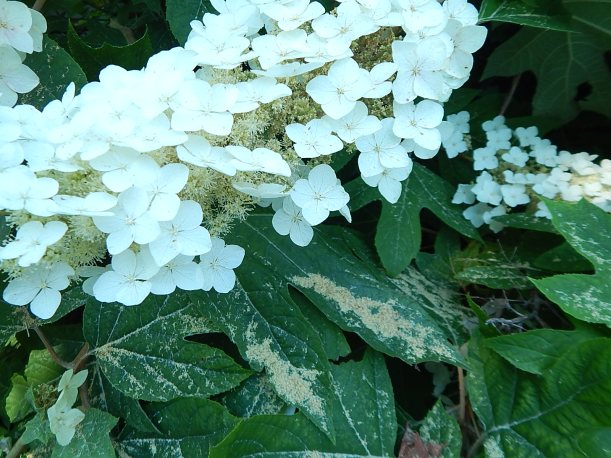
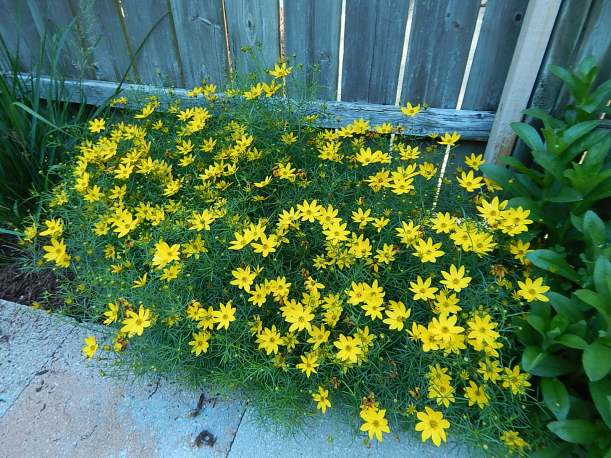

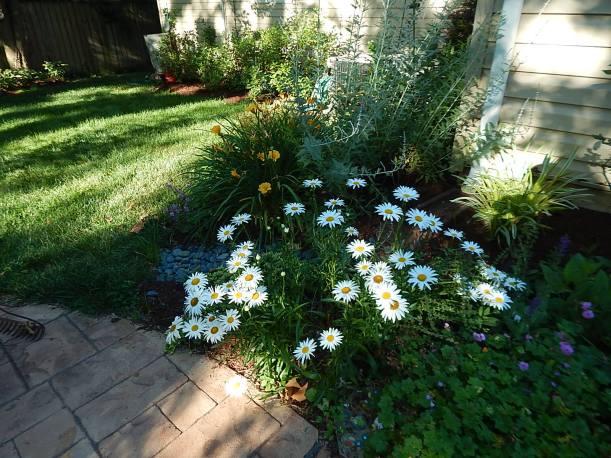
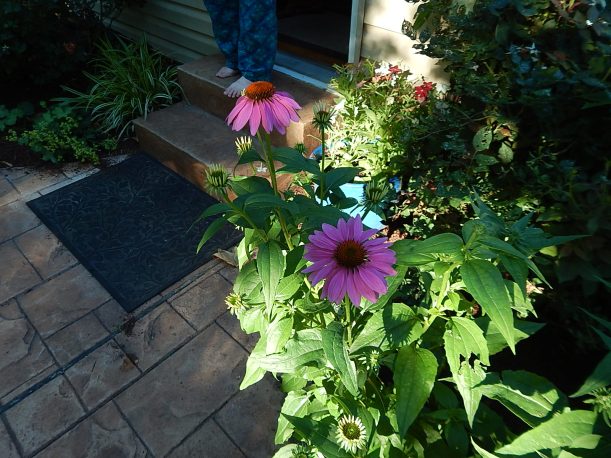
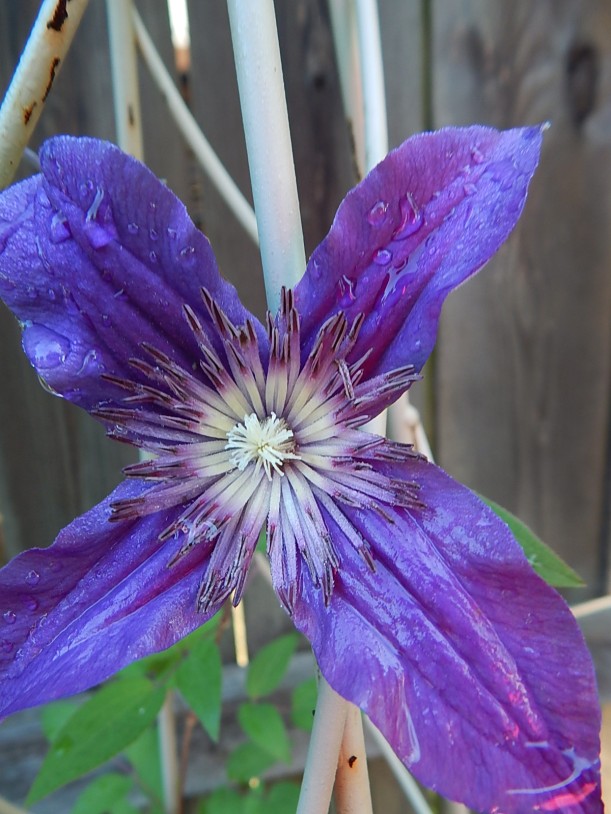

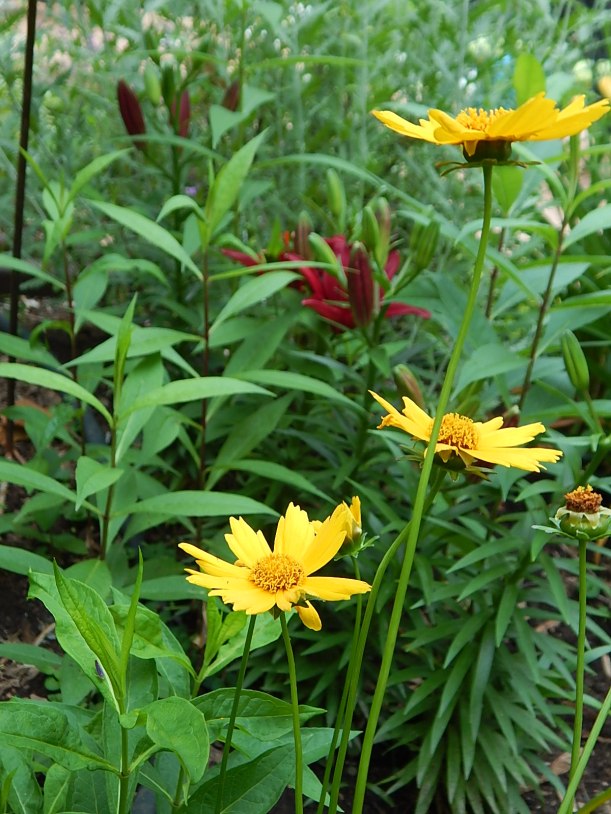












At the end of April, I posted photos showing how much progress had been made from the start of the month to the beginning of May. Of course, Mother Nature was just getting tuned up. To lean on the old, tired adage “April Showers Bring May Flowers,” I know why Mother’s day, weddings and graduations fill the weekends of May–because it’s so doggone beautiful.
I have not yet mulched. Shame on me but my gutter man has not shown up! And while I know the mulch will make the beds look that much better and be beneficial to the beds, all the rain and nice spring temperatures have really brought on the blooms. The only bed that really looks shabby is along the fence line where the Cannas are starting to emerge. It could use some mulch. And the bed in the corner of the backyard looks terrible, but more about that deliberately neglected space later.
This post isn’t to dive into the rough spots of the yard, but to celebrate how lovely May is.
Let’s take a look at how things are coming along, shall we?
Not shy on ambition, I envisioned a plant-packed bed, spilling forth with flowers throughout spring, summer and fall when I started this project three years ago. And it is taking a lot longer than I thought. I am trying to be patient and let the shrubs fill in, the Japanese maple put some height on and the dwarf Colorado blue spruce fill out, but I am like a kid–I want it now. May was spent dividing hosta, coreopsis, shasta daisy, black eye Susan and other perennials in the beds. They payback is that I save money on plants and have some much-needed repetition, which provides some continuity to this project.
The “May Night” salvia are attracting lots of bees as are the cranesbill. I really like this combination. This must be the perfect spot for the cranesbill because it was the first thing I planted in my new garden in the summer of 2011. The salvia tends to get a bit leggy and last year–its first summer–I cut it back quite a bit. Clearly that didn’t both it!
Pink and purple plants took center stage in early May but now the yellows are starting to show. The coreopsis are balancing atop their delicate stems, and the stella de oro are blooming. Later this summer, the black eye Susans will be out in force.

This variety of coreopsis blooms all summer but requires a bit of maintenance trimming off the spent blooms.
I have been looking forward to watching gayfeather (liatris spicata) come through this year. I planted three of them last year. One did not make it but these two look terrific. It looks like they will bloom soon.
True to their promise, the Knockout roses are providing a profusion of blooms. I am really enjoying this pink shrub. It was mislabeled as a deep pink but it turns out it was a happy accident. It’s also encouraging to see how quickly these guys grow.
Nothing seems to have grown as quickly as the Oakleaf hydrangea! This bad boy either a) loves this spot on the north side of the house; b) is a vigorous grower; or c) all of the above. I think the answer is c) all of the above. This specimen is actually in the middle of this particular bed. When sitting on the patio, it towers above the rose. Behind it, where there is more shade from the eaves of the roofline, I have put in shade lovers such as coral bells, astilbe, hosta and fern. Originally, I had intended the oakleaf to screen the trash cans. This year I decided to move them to the other side of the house and expand this bed. That’s the gardening way, right?
Until May, I had not given much thought on which month I really enjoy in the yard. While early spring provides much-needed anticipation and relief from being inside all winter, the temperatures this May have been good (not too hot or humid). The humidity and temps are starting to climb but it has been a great month to enjoy the yard.
Having something blooming each month throughout the summer is one of the key benefits to gardening. You can bring the outdoors inside with vases of cut flowers, a joyful reminder of the garderner’s hard work paying off.
I like to I look forward to providing an end-of-June report and watching what’s growing in your yard, fellow bloggers.
Thanks for reading.

The black eye Susan here in front of the yellow coreopsis, love this location. Other sun lovers include monarda, tall garden phlox, lily and Russian sage. On the left is a blue false indigo (baptisia australis), a new addition to the bed this year.

The soft velvety texture of artemesia, seen here creeping on the edge of the patio almost cries out to be touched. What really took off this month, though, is the Oakleaf hydrangea in the back of this photo.

I have concentrated on planting in the sunny spots in the yard but have found a few shady areas to fill in. Contrasting shapes and color provide visual interest.
Life in the backyard is abuzz with growth! Just one month ago, perennials were just beginning to push their way through the soil. Take a look and see for yourself the plant progress in my St. Louis garden.

This bed beneath the family room window and bordering the patio, looked rather barren on March 29. The small bit of green is Meadow Sage.
I had yet to trim back the roses and still need to add mulch. There are four KnockOut rose shrubs in this bed, three of them planted last year. This bed faces east and gets lots of morning sun as well as sun from the south.

Mother Nature is not the only one who has been busy. I have added the rocks to better direct the drainage from the downspout, cleaned out the bed and trimmed the roses. I have added a few plants as well, although the vast majority are perennials planted over the past three years.
This is one of my favorite beds. Everything I have put in this bed has been happy, happy, happy as Phil would say on Duck Dynasty. In addition to the roses and Mianacht salvia (salvia x sylvestris), there are Cranesbill Biokova Karmina (geranium x cantabrigiense) which edge the bed. These mounding plants have wonderful year round interest, their leaves turning deep green to crimson red in the fall and winter. In early summer they are filled with small rose-hued flowers. Filling in the bed are Shasta daisy(Leucanthemum × superbum), variegated lily turf (liriope muscari), threadleaf coreopsis and new this season, Lady’s Mantle (Alchemilla mollis). I added the lady’s mantle to the north end of the bed, near the door, to bring some yellow to that end of things. I also transplanted a small and struggling shasta that had been in a bed near the fence. Anchoring the bed near the rocks on the south end is a low-to-the ground, creeping juniper (Juniperis horizontalis). This evergreen has lots of yellow in, which complements the hot pink of the roses and brightens the deep purple of the salvia.
I also like this bed because it wraps around to the south, which gets gobs of sun. It begins its southern turn where the Russian Sage (Perovskia atriplicifolia) is anchored. I added two Stella D’Oro lilies(Hemerocallis) to play off the color in the juniper and contrast with the cool lavender of the Russian Sage. This small grouping is a nice segue to the south-facing part of the bed. I’ll share more of that in another post.
How’s your garden growing?
Advice and Tips on How to Garden
Our garden, gardens visited, occasional thoughts and book reviews
Horticulturist, Arborist and Garden Columnist
Thoughts about life, creating, and gardening....
Musings about gardening, the natural world and things creative.
Learning life's lessons in the garden!
the great outdoors, wellbeing and life in the North
Journeys In St. Louis Gardening and Beyond
America's Favorite Rose Gardener
A region, a garden, a frame of mind...
"How quickly comes the sun when first it sets its mind to rise." - - j. s. v.
tales from deep in my soil
Cariboo-Grown & Cariboo-Hardy Perennials. Since 1991.
A Gardening Blog. Mostly
.....and nurturing my soul